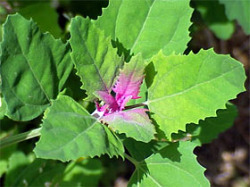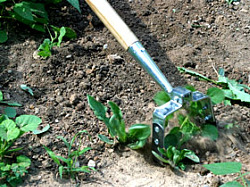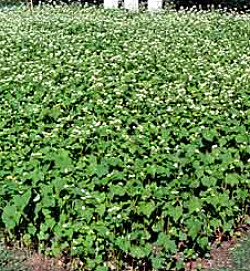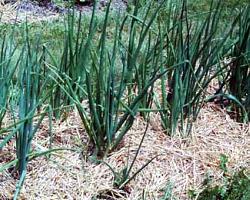
Lamb's quarters is a beautiful and very edible weed that tastes great in salads when picked young.
Now that the vegetable garden is all planted, not only are your seeded squash, cucumbers, lettuces, beans, and carrots coming up, so are the weeds. There are perennial and annual weeds in most gardens. The perennial weeds, such as dandelions and quack grass, come up every spring, usually before you even get into the garden to plant. Annual weeds, such as lamb's quarters, purslane, galinsoga, and redroot pigweed (amaranth), are more opportunistic. There are literarily thousands of weed seeds in most garden soils. When you disturb the soil to plant, you are bringing weed seeds to the soil surface where light and warmth allow them to germinate. Plus, you can be bringing weed seed into your garden from compost or manures.
To control perennial weeds you need to dig them out — root and all. I won't be tackling that issue here. Annual weeds can be easier to control if you stay on top of the situation. Here are my 10 steps for controlling annual weeds in your vegetable garden.

When weeding, try not to dig deeper than a few inches into the soil to avoid bringing weed seeds to the surface to germinate.
1. Don't Till – While most gardeners are already planted, this is a good reminder for next year's garden and for gardeners who use a rototiller to weed between rows. The more you till, the more weed seeds are brought to the soil surface to germinate. Consider moving to a low or no till gardening system to keep the weed seeds buried. Also, avoid adding partially decomposed manures to your garden. Some, such as horse manure, can contain lots of weed seed. Lee Reich's book, Weedless Gardening (Workman, 2001) is a great guide to no-till gardening.
2. Identify Your Weed – Know the weed you're dealing with before you start pulling or hoeing. Make sure it's a weed and not one of your vegetable seedlings. Check out the Weed Library for proper weed identification.
3. Weed Early – If you weed early in the season,, you'll have fewer problems later in the growing season. Remove annual weeds before they reach 3 inches tall. Preferably on a sunny day, using a sharp-edged hoe, gently slice the weeds just below the soil surface to kill them. The sun will help kill the weeds so they don't resprout. Slicing the weeds less than 2 inches below the surface will avoid bringing more weed seeds to the surface.

Buckwheat is a good cover crop to smother weeds and build the organic matter in your soil.
4. Grow Weed Smothering Crops – Some vegetables compete better with weeds than others and once established, will be able to smother annual weeds. Crops such as tomatoes, squash, melons, potatoes, cabbage, and beans grow quickly in warm soils and can outgrow the weeds. Plus, they are large enough to shade out weeds growing later in the season. Vegetables such as lettuce, carrots, onions and radishes don't compete well with weeds and your yields will be reduced if you don't weed well early and often..
5. Add Organic Mulches – Once you've weeded a few times and your plants have germinated and are growing vigorously, consider adding an organic mulch. Organic mulches such as straw, pine straw, bark mulch, grass clippings from untreated lawns, and chopped leaves will keep the soil cool, moist, and less weedy while adding organic matter to the soil as they break down. Avoid using hay because it has weed seeds in it. Add a 2- to 3-inch thick layer of mulch around established plants. Organic mulches are best used on cool season vegetables, such as broccoli, cabbage, lettuce, and peas. If you are going to use them on warm season vegetables such as tomatoes, melons, peppers, and beans, wait until the soil has warmed into the 60Fs before applying the mulch.
6. Add Inorganic Mulch – Another way to mulch is to lay black, green, or red plastic mulch down on the beds before planting. These inorganic mulches warm the soil by 6 to 8 degrees and by poking holes and planting right into the mulch, the roots can take advantage of the warm soil and the plants will grow faster. They also keep weeds from germinating. It's best to run a soaker hose or drip irrigation line under the plastic mulch to keep the plants well watered. Most plastic mulches can be reused for 2 to 3 years if you're careful when pulling them up in fall.

Mulch with straw after weeding to keep the soil moist and prevent more weeds from growing.
7. Mulch Pathways – There's no reason to be weeding pathways. Pathways between rows of crops can be mulched at planting with any material that will prevent weed growth. Cardboard, bark mulch, straw, even old rugs can be used to stop weed growth. Some of the heavier materials, such as cardboard and old rugs, will not break down quickly and may need to be removed come fall.
8. Don't Let Weeds Go to Seed – Weed plants can reproduce prolifically. For example, one plant of redroot pigweed can produce more than 100,000 seeds in one season. If you get behind in your weeding, at least cut them down to prevent weed seeds from forming.
9. Grow Cover Crops – If you're battling lots of annual weeds in your garden, consider growing a cover crop to smother them and add organic matter to the soil. Buckwheat is a fast growing cover crop that will smother weeds. Consider planting winter rye in the fall, then turning it under in spring. The residue has been known to reduce pigweed, purslane, and lamb's quarter seed germination rates by 75%.
10. Eat Your Weeds – Weeds aren't all bad. After all, the definition of a weed is a plant growing in the wrong place. Many weeds are edible and taste great. Harvest lamb's quarters, purslane, and pigweed when they are young and add them to salads. Mix chickweed in with basil and parsley to make a great pesto.
More Stories on Weed Control in the Vegetable Garden:Weeds in Your Garden
Weeding Woes
Cultivating the Garden
 Charlie Nardozzi is an award winning, nationally recognized garden writer, speaker, radio, and television personality. He has worked for more than 30 years bringing expert gardening information to home gardeners through radio, television, talks, tours, on-line, and the printed page. Charlie delights in making gardening information simple, easy, fun and accessible to everyone. He's the author of 6 books, has three radio shows in New England and a TV show. He leads Garden Tours around the world and consults with organizations and companies about gardening programs. See more about him at Gardening With Charlie.
Charlie Nardozzi is an award winning, nationally recognized garden writer, speaker, radio, and television personality. He has worked for more than 30 years bringing expert gardening information to home gardeners through radio, television, talks, tours, on-line, and the printed page. Charlie delights in making gardening information simple, easy, fun and accessible to everyone. He's the author of 6 books, has three radio shows in New England and a TV show. He leads Garden Tours around the world and consults with organizations and companies about gardening programs. See more about him at Gardening With Charlie.
 Victory Seed Company has all the seeds you want for your best garden in 2024.
Victory Seed Company has all the seeds you want for your best garden in 2024.
For 25 years, the family-owned Victory Seed Company has provided the highest quality vegetable, herb and flower seeds to families across the country. We are passionate about providing you the best seeds available that give excellent germination, robust plants, and the harvest you want. With a catalog of over a thousand varieties, we have everything, and our prices are the kinds that we'd want to pay. We have hundreds of yesterday's heirloom vegetables, as well as today's award winning hybrid selections. Get to know us by visiting our website and browsing through our online vegetable seed catalog.